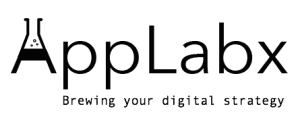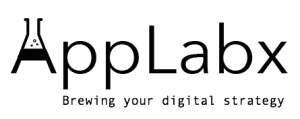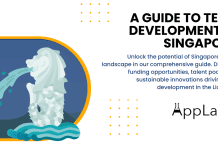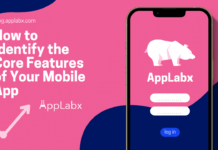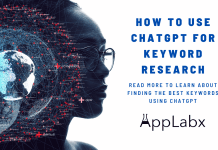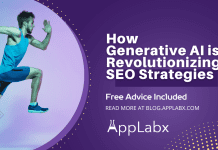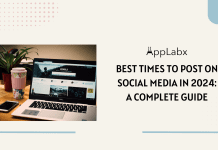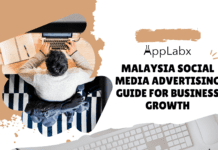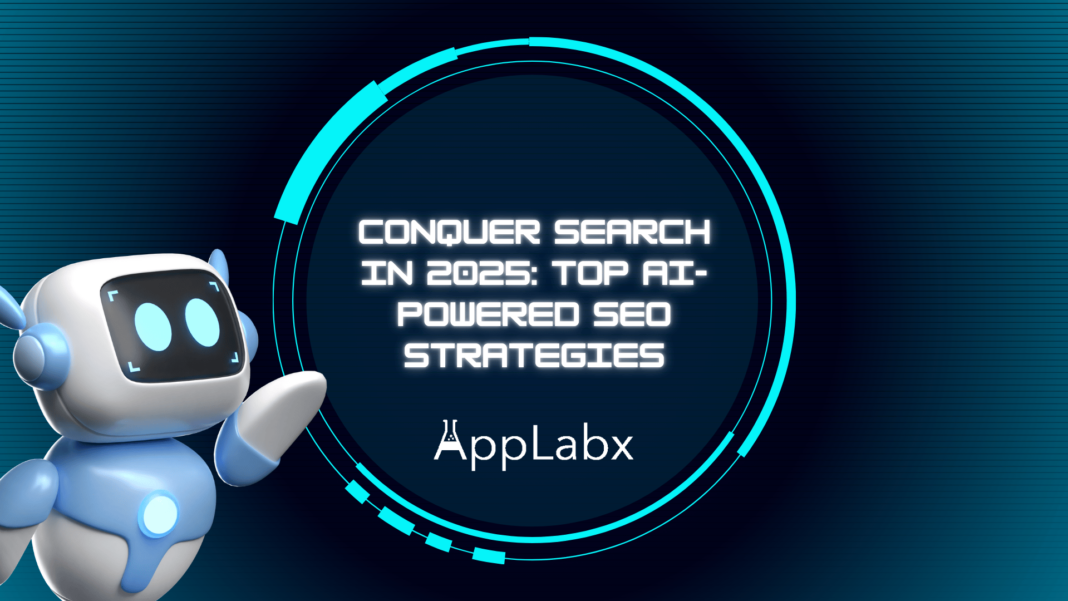Key Takeaways
- AI Transforms SEO Efficiency: Leverage AI tools for smarter content creation, search intent analysis, and predictive analytics to boost rankings and engagement.
- Adapt to Emerging Trends: Optimize for voice, visual, and local search with AI-driven insights to stay ahead in the evolving search landscape.
- Ethical AI Use is Crucial: Maintain transparency, prioritize user privacy, and focus on delivering valuable content for sustainable SEO success in 2025.
The digital marketing landscape has been rapidly evolving, and nowhere is this transformation more evident than in the field of Search Engine Optimization (SEO).
As we look ahead to 2025, the role of Artificial Intelligence (AI) in shaping search algorithms, content creation, and user experience is becoming undeniably crucial.
If you haven’t already started adapting to AI-powered SEO strategies, now is the time to prepare for a future where AI doesn’t just enhance SEO – it revolutionizes it.
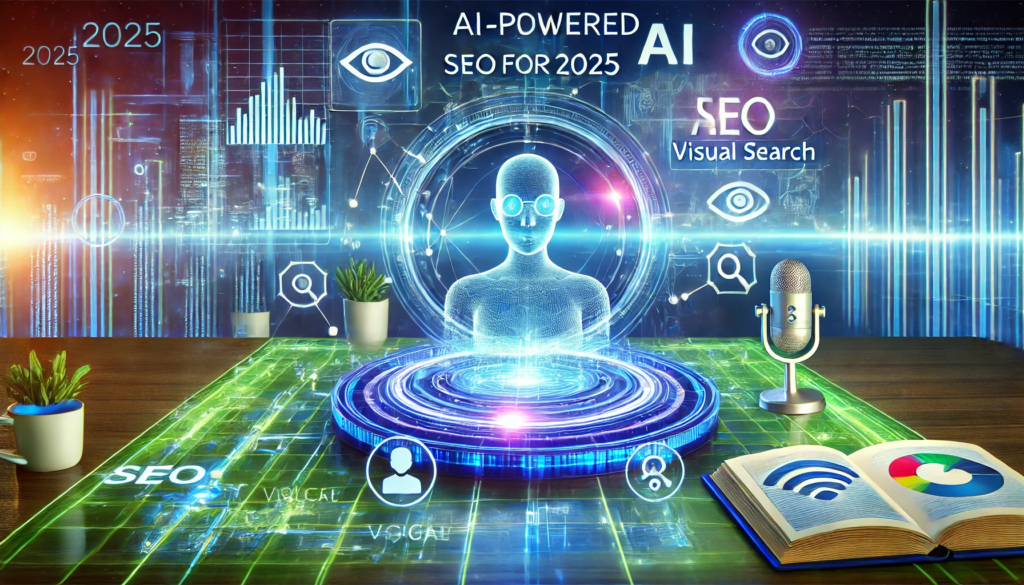
In the early days of SEO, marketers primarily focused on keyword optimization, backlinks, and technical elements like meta descriptions. While these strategies still hold value, they’re no longer enough to dominate the search rankings.
The rise of AI and machine learning (ML) technologies has significantly changed the way search engines operate, with algorithms becoming increasingly sophisticated in understanding search intent, content relevance, and user behavior.
Search engines like Google have already integrated AI tools such as BERT and MUM to provide users with more accurate, contextually relevant search results.
These AI systems aim to understand the nuances of human language, making it imperative for digital marketers to rethink traditional SEO tactics and adopt cutting-edge AI-driven strategies.
By 2025, AI-powered SEO will not just be a trend; it will be a necessity.
The way you approach content creation, keyword research, link building, and even user experience will be transformed by AI tools and algorithms that can analyze massive amounts of data in real-time.
With search engines continuing to evolve, your SEO efforts need to adapt to an AI-driven ecosystem, where understanding user intent and delivering hyper-relevant content is more important than ever.
But how can you harness the full potential of AI for SEO?
What tools and strategies will help you stay ahead of the curve? In this comprehensive guide, we’ll explore the most effective AI-powered SEO strategies that can help you conquer search rankings in 2025 and beyond.
From AI-driven content creation to predictive analytics, we’ll dive into the cutting-edge technologies and techniques that will set you apart from your competitors.
Whether you’re an SEO professional looking to optimize your campaigns or a business owner trying to stay competitive in the digital marketplace, AI is your gateway to success.
It’s no longer just about ranking for a set of keywords – it’s about delivering the right content to the right user, at the right time, with the help of AI.
In this article, we’ll show you exactly how to make AI a core component of your SEO strategy and ensure that you stay at the forefront of search innovation.
In the following sections, you’ll learn about AI’s impact on everything from content creation and search intent analysis to voice search optimization and predictive analytics.
We’ll also look at practical tools and techniques that can help you streamline your SEO processes and boost your search rankings with minimal effort.
By the end of this guide, you’ll have a solid understanding of the AI-powered strategies that will dominate SEO in 2025 and be equipped with the knowledge to implement them effectively.
So, let’s dive into the future of SEO, where artificial intelligence takes the lead in helping you conquer search in 2025.
Understanding AI’s Impact on SEO
The integration of Artificial Intelligence (AI) into SEO has fundamentally reshaped how search engines process queries, evaluate content, and rank websites. As search algorithms grow increasingly sophisticated, AI plays a crucial role in refining SEO strategies to meet the demands of a more intuitive, context-aware search landscape. Understanding the ways AI impacts SEO is essential for staying ahead in the competitive digital space.
What is AI in SEO?
- Definition of AI: Artificial Intelligence refers to technologies that enable machines to perform tasks typically requiring human intelligence, such as understanding language, learning from data, and making decisions.
- AI in SEO: AI refers to various technologies, including machine learning (ML), natural language processing (NLP), deep learning, and predictive analytics, which help search engines better understand and rank web content based on context, intent, and relevance.
The Evolution of Search Engines with AI
AI’s influence on search engine algorithms has become more pronounced in recent years, especially as search engines like Google have rolled out AI-focused updates. These advancements allow search engines to interpret queries with greater accuracy, providing users with more relevant search results.
- Google’s BERT Update: BERT (Bidirectional Encoder Representations from Transformers) is an AI-powered algorithm update that helps Google better understand natural language, particularly long-tail searches and conversational queries.
- Example: For the query “how to fix a leaking kitchen faucet,” BERT helps Google understand that the searcher is likely looking for a solution to the problem, not just general information about faucets.
- Impact: It enables Google to offer results that reflect deeper understanding and context, improving user experience.
- Google’s MUM (Multitask Unified Model): MUM is a newer AI model designed to handle complex queries that may require multiple steps or diverse information to answer.
- Example: A user searching “How do I plan a 10-day road trip across the USA in an electric car?” can receive information on routes, charging stations, optimal driving conditions, and car models—all in one search result.
- Impact: MUM is designed to handle multimodal queries, including text, images, and video, and provides a more comprehensive answer based on diverse content sources.
AI for Understanding Search Intent
AI has revolutionized how search engines understand user intent, helping to refine search results beyond just keywords.
- Traditional SEO: SEO once relied on keyword matching, where ranking algorithms matched search queries to relevant keywords in web content.
- AI in Search Intent: Today, AI is able to analyze and interpret the intent behind a search query, whether it’s transactional, informational, or navigational.
- Example: If a user searches “buy running shoes,” AI understands this as a transactional intent and will prioritize eCommerce sites, reviews, and product pages in search results.
- Example: A search for “how to run a marathon” signals informational intent, so AI will prioritize blogs, guides, and training resources.
AI and Content Quality Evaluation
AI helps search engines assess content quality, relevance, and comprehensiveness by analyzing multiple factors such as user engagement signals, content depth, and semantic relevance.
- RankBrain: Google’s RankBrain, powered by AI, analyzes user behavior and engagement signals to determine the relevance of content.
- Example: If users click on a specific link, spend time on the page, and engage with the content (scrolling, commenting), RankBrain takes this as a signal that the page is relevant and informative.
- Impact: Content that keeps users engaged is rewarded with higher rankings. AI algorithms can evaluate whether content provides real value or just superficial answers.
- Natural Language Processing (NLP): NLP allows search engines to better understand the meaning behind the words, even when they are semantically similar or contextually different.
- Example: The phrases “best pizza in New York” and “top-rated pizza spots in New York” are different but essentially mean the same thing. AI helps search engines understand that these terms are interchangeable in context.
- Impact: NLP leads to improved ranking of content that answers a user’s query more accurately, regardless of the exact keywords used.
AI-Powered User Experience (UX) and SEO
User experience plays a critical role in SEO, and AI is now central to optimizing how users interact with websites. Search engines prioritize websites that provide a seamless, engaging experience.
- Personalization: AI allows search engines to deliver personalized search results based on a user’s browsing history, location, and preferences.
- Example: A user searching for “Italian restaurants near me” might see different results based on their past interactions with food delivery services or reviews in their area.
- Impact: Personalized search results help businesses cater to users’ needs more effectively, increasing their chances of ranking higher in localized searches.
- AI-Powered UX Tools: Tools like Hotjar, Crazy Egg, and Microsoft Clarity use AI to analyze user behavior, heatmaps, and interaction patterns.
- Example: AI can help identify drop-off points on a website where users lose interest and improve the layout or content to retain engagement.
- Impact: Better UX can lower bounce rates, increase time on site, and improve overall rankings.
AI in Technical SEO and Automation
AI is revolutionizing technical SEO by making it easier to identify and fix issues that impact site performance.
- Site Audits: AI-powered tools like SEMrush, Ahrefs, and Screaming Frog can automatically identify issues such as broken links, duplicate content, slow page load times, and crawl errors.
- Example: An AI-driven audit tool can instantly generate a report with prioritized actions to fix issues, saving hours of manual work.
- Impact: Automating technical SEO processes allows marketers to spend more time on strategy and content creation rather than routine tasks.
- AI for Predictive Analytics: AI helps forecast SEO performance by analyzing data trends and predicting which strategies will yield the best results.
- Example: Predictive analytics tools can estimate traffic, backlink growth, and keyword ranking based on historical data and current trends.
- Impact: Marketers can focus on high-impact SEO efforts and adjust strategies based on AI-driven insights.
AI’s Role in Voice Search Optimization
With the growing use of voice assistants like Google Assistant, Siri, and Alexa, voice search optimization has become a critical aspect of SEO.
- NLP and Voice Search: AI-powered NLP technologies allow search engines to process spoken language with a high degree of accuracy.
- Example: A voice search query like “What’s the weather like in New York tomorrow?” is processed in a conversational tone and returned with specific, contextually relevant results.
- Impact: As voice search continues to grow, SEO strategies must optimize for natural, conversational queries, often involving long-tail keywords and question-based searches.
AI and Predictive SEO Strategies
AI is taking SEO beyond the realm of reactionary tactics to predictive strategies, where search marketers can forecast trends and make proactive adjustments to campaigns.
- SEO Forecasting: AI tools like BrightEdge and Conductor offer predictive insights that help businesses anticipate changes in search trends and algorithm updates.
- Example: An AI-powered tool can predict that a surge in interest for a particular topic or product is likely, allowing marketers to create content ahead of the curve.
- Impact: Predictive SEO allows businesses to act before trends hit, securing a competitive edge in the search rankings.
As we can see, AI is not just an enhancement to SEO—it’s reshaping the way search engines work and how marketers approach search strategies. From understanding user intent to improving content quality and automating technical tasks, AI is fundamentally transforming SEO practices. Staying ahead of these innovations is key to maintaining high rankings in 2025 and beyond.
But, before we venture further, we like to share who we are and what we do.
About AppLabx
From developing a solid marketing plan to creating compelling content, optimizing for search engines, leveraging social media, and utilizing paid advertising, AppLabx offers a comprehensive suite of digital marketing services designed to drive growth and profitability for your business.
AppLabx is well known for helping companies and startups use SEO to drive web traffic to their websites and web apps.
At AppLabx, we understand that no two businesses are alike. That’s why we take a personalized approach to every project, working closely with our clients to understand their unique needs and goals, and developing customized strategies to help them achieve success.
If you need a digital consultation, then send in an inquiry here.
Conquer Search in 2025: Top AI-Powered SEO Strategies
- AI-Driven Content Creation and Optimization
- Voice Search Optimization: AI’s Growing Role
- AI and Search Intent Understanding
- AI in Link Building and Outreach
- Predictive Analytics: AI’s Advantage in SEO Forecasting
- AI-Powered Visual and Video Search Optimization
- AI and Local SEO: Personalizing Search Results
- Ethical Considerations in AI-Driven SEO
1. AI-Driven Content Creation and Optimization
As AI continues to revolutionize the digital marketing landscape, its role in content creation and optimization has become indispensable for SEO success. Content is at the heart of every SEO strategy, and AI provides tools that help create high-quality, optimized content at scale. This section will explore how AI is transforming the content creation process, improving content relevance, and ensuring optimal performance in search rankings.
The Role of AI in Content Creation
AI-driven tools have made it easier for content creators to generate relevant, high-quality content quickly and efficiently. These tools leverage natural language processing (NLP), machine learning (ML), and deep learning to understand language nuances, improve readability, and generate content that meets both user intent and SEO standards.
- AI Content Generation Tools: AI writing assistants like GPT-3 (and now GPT-4), Jasper, and Copy.ai are capable of generating blog posts, product descriptions, social media content, and more based on given prompts.
- Example: A digital marketer can input a few keywords or a topic into an AI tool like Jasper, and it will generate a full-length blog post, complete with SEO-optimized headings, internal links, and relevant keywords.
- Impact: These tools save time and allow for the production of high-volume content while ensuring it is tailored to search engine algorithms and user needs.
- AI for Creative Content: AI can help create content with a creative edge, producing not only informative text but also engaging material such as storytelling, visual elements, and personalized messages.
- Example: AI-powered platforms like Lumen5 or InVideo can transform a blog post into a captivating video, complete with voiceovers, animations, and background music, for better engagement across platforms.
- Impact: By producing creative content formats (e.g., video summaries, infographics, etc.), AI enhances user engagement, a critical ranking factor for SEO.
Optimizing Content for SEO with AI
AI is not just about creating content; it’s also about ensuring that the content is optimized for search engines, improving the chances of ranking higher in the search results. AI tools can analyze your content and suggest ways to improve keyword targeting, readability, and overall relevance.
- Keyword Optimization: AI-powered tools like SurferSEO and MarketMuse can help identify high-performing keywords and semantically related terms to target in your content.
- Example: SurferSEO analyzes top-ranking pages and suggests keyword adjustments based on search volume, keyword difficulty, and competitive analysis, allowing content creators to better optimize their articles.
- Impact: AI can help refine keyword targeting to ensure your content ranks for the right terms, enhancing its visibility on search engines.
- Content Gap Analysis: AI can scan competitors’ content and identify gaps in your own content strategy.
- Example: Tools like MarketMuse use AI to compare your content with that of competitors, identifying topics or subtopics that you may have missed. This allows you to optimize your content for more comprehensive coverage of a subject.
- Impact: By filling these gaps, you create more authoritative and informative content, which search engines value for ranking.
- Semantic SEO and NLP: With AI, content optimization now goes beyond keyword usage. Tools powered by NLP, like Clearscope and Frase, help ensure that your content covers a topic comprehensively with semantically related terms and variations.
- Example: Clearscope analyzes top-ranking content and recommends words and phrases that are contextually related to the primary keyword, helping the content cover all possible angles.
- Impact: Using semantic SEO techniques improves your content’s relevance and alignment with user intent, which is crucial for ranking well in modern search engines.
AI for Content Personalization
Personalization is key to improving user engagement and conversion rates. AI enables marketers to tailor content to specific audience segments, ensuring that the right message reaches the right person.
- Dynamic Content Creation: AI can personalize content based on user data, such as location, browsing history, and demographic information.
- Example: An eCommerce website might use AI to present personalized product recommendations, discount offers, or articles based on a user’s past behavior.
- Impact: Personalized content leads to higher engagement, longer time on site, and increased chances of conversion, which are positive signals for SEO.
- AI for Customer Journey Mapping: AI tools like HubSpot and Salesforce Einstein analyze customer behavior to predict the best types of content to engage with potential customers at various stages of the buying funnel.
- Example: If a user has previously read blog articles on a particular topic, an AI-driven tool can recommend content that’s aligned with that user’s journey, such as case studies or product demos.
- Impact: By delivering the right content at the right time, you increase user satisfaction and engagement, which boosts SEO rankings.
AI-Generated Content that Passes the “E-A-T” Test
Search engines like Google prioritize content that demonstrates Expertise, Authoritativeness, and Trustworthiness (E-A-T). AI tools can assist in producing high-quality, credible content that aligns with these criteria.
- Ensuring High-Quality Content: AI-driven tools like Grammarly and Hemingway Editor help refine grammar, style, and readability, ensuring that the content is polished and professional.
- Example: An AI tool might flag passive voice, poor sentence structure, or overly complex vocabulary, offering suggestions to enhance clarity and readability.
- Impact: Content that is clear, authoritative, and easy to read is more likely to be valued by both users and search engines, boosting its E-A-T score.
- Citing Authoritative Sources: AI can also help identify high-authority sources and reference them in your content to improve credibility.
- Example: AI tools like SEMrush or Frase analyze top-ranking pages to suggest authoritative sources to link to, ensuring your content has credible backlinks and references.
- Impact: Citing authoritative sources and obtaining high-quality backlinks boosts your content’s trustworthiness, which is a key component of ranking higher.
AI for Content Structuring and Readability
AI doesn’t just focus on content generation; it also helps ensure that content is structured and formatted for optimal user experience. Readable, well-structured content is more likely to retain users, and this improves SEO performance.
- Optimizing Headings and Subheadings: AI-powered tools like SurferSEO and Yoast SEO analyze content structure and recommend optimal heading tags (H1, H2, H3) for better readability and SEO.
- Example: AI can suggest whether the content would benefit from breaking longer paragraphs into shorter, more digestible sections or reorganizing headings to improve content flow.
- Impact: Content with well-optimized headings and a logical structure enhances user experience and ranks better in search engines.
- Content Readability Analysis: AI tools like Hemingway and Readable.io evaluate the readability of content, providing insights into sentence length, complexity, and word choice to make the text more accessible.
- Example: An AI tool might suggest simplifying a complex sentence like “In light of recent economic data, it seems that the overall business environment may present some challenges” to “Recent economic data shows potential challenges for businesses.”
- Impact: Readable content enhances user engagement and time spent on page, which is a positive ranking signal for search engines.
AI-Enhanced Content Updates and Maintenance
AI helps marketers keep their content fresh and up-to-date, ensuring that older articles remain relevant and competitive in search results.
- AI for Content Refreshes: Tools like Frase and SEMrush can suggest content updates by analyzing search trends, competitor content, and performance data.
- Example: If a blog post on “2023 SEO Trends” begins to show a decline in traffic, an AI tool can suggest incorporating new SEO trends and updating outdated links.
- Impact: Regularly updated content not only remains relevant but also ranks higher in search engines due to its freshness.
- AI for Continuous Optimization: AI-powered platforms track how well your content is performing and recommend adjustments to improve rankings.
- Example: An AI tool can monitor keyword performance over time and suggest more competitive keywords to target, or recommend additional subtopics based on emerging trends.
- Impact: By continuously optimizing content, you ensure that it remains valuable and competitive in the ever-evolving SEO landscape.
AI-driven content creation and optimization are reshaping the way marketers approach SEO. By leveraging AI tools for content generation, keyword optimization, personalization, and user experience, you can create high-quality, SEO-friendly content that not only ranks higher but also engages users effectively. As we move into 2025, embracing AI will be essential for staying ahead of the competition and ensuring that your content remains relevant, authoritative, and optimized for both users and search engines.
2. Voice Search Optimization: AI’s Growing Role
As the use of voice-activated devices like smartphones, smart speakers, and virtual assistants continues to rise, optimizing for voice search has become a crucial element of modern SEO strategies. Voice search is fundamentally changing the way people interact with search engines, and AI is playing a pivotal role in understanding and processing spoken queries. In this section, we’ll explore how AI is shaping voice search optimization, its impact on SEO, and strategies you can implement to stay ahead of the curve in 2025.
The Rise of Voice Search and AI’s Role in Its Growth
Voice search has rapidly gained popularity due to the convenience it offers. With AI advancements, voice search technology is now more accurate, faster, and capable of understanding complex queries.
- Increasing Use of Voice Search: According to recent studies, over 50% of searches are expected to be voice-based by 2025. Devices such as Amazon Alexa, Google Assistant, and Apple’s Siri are becoming household staples.
- Example: A user might simply ask, “Hey Siri, what’s the weather like today in New York?” instead of typing out a similar query on Google.
- Impact: With this rise in voice search usage, voice search optimization has become crucial for businesses wanting to capture traffic from users relying on virtual assistants for information.
- AI’s Role in Processing Voice Queries: AI technologies such as Natural Language Processing (NLP) and machine learning (ML) are responsible for enabling voice assistants to understand, interpret, and respond to user queries.
- Example: Google Assistant, powered by AI, processes voice queries, understands their context, and responds with personalized information. If you ask, “Where’s the closest coffee shop?” Google Assistant takes into account your location and search history to provide an accurate answer.
- Impact: AI allows voice search to be conversational, more intuitive, and context-aware, which directly influences how businesses need to optimize their content.
How AI Enhances Voice Search Understanding
AI’s ability to process and understand human language has been one of the most significant developments in the evolution of voice search. This capability allows voice assistants to interpret complex, long-tail, and conversational queries with remarkable accuracy.
- Natural Language Processing (NLP): NLP enables voice search systems to decode the structure and meaning behind spoken language, including slang, regional dialects, and complex sentence structures.
- Example: A voice search query like “What’s the best sushi in downtown Chicago for date night?” is parsed by AI’s NLP algorithms to understand not only the request but also the context behind it—date night, sushi, and location.
- Impact: NLP allows for more accurate search results and helps voice assistants prioritize content that answers specific, conversational queries, making it essential for businesses to craft content that mimics natural speech.
- Speech Recognition: AI-powered speech recognition converts spoken words into text, making it possible for search engines to process and understand voice commands.
- Example: If a user asks, “How can I improve my website’s SEO?” AI’s speech recognition technology transcribes this speech into text, while AI models analyze the text for search intent.
- Impact: Advanced speech recognition technology helps voice assistants understand more diverse speech patterns, accents, and languages, which impacts the kind of content that ranks well in voice search.
Voice Search Queries: How AI Changes User Behavior
Voice search queries differ from text-based searches, and understanding these differences is essential for effective optimization. AI is playing a key role in making these searches more context-aware, allowing voice search to understand the nuances of each query.
- Conversational Search Queries: Unlike traditional text searches, voice searches tend to be longer, more conversational, and phrased in a way people naturally speak.
- Example: Instead of typing “best sushi restaurant Chicago,” a user might ask, “What are the best sushi restaurants in Chicago for a romantic dinner?”
- Impact: As voice search becomes more conversational, AI is crucial in understanding the intricacies of these natural queries, leading to a greater emphasis on long-tail keywords and content that answers questions in a natural, fluid manner.
- Context and Location-Based Queries: AI uses context, location, and previous search behavior to interpret queries, which is especially important for mobile users.
- Example: A user asking, “Where can I get pizza near me?” will be shown results based on their GPS location, providing localized recommendations.
- Impact: Optimizing for voice search means focusing on location-specific content and ensuring that your business is well-represented in local search listings (e.g., Google My Business).
Optimizing Content for Voice Search with AI
To capitalize on the growth of voice search, businesses need to adapt their content strategy to align with the specific requirements of voice search. AI can help optimize your content for voice queries by making it more conversational, context-aware, and location-specific.
- Long-Tail Keywords: AI tools such as Ahrefs, SEMrush, and SurferSEO can help identify long-tail keywords and phrases commonly used in voice searches. These often include question words like “who,” “what,” “where,” “how,” and “why.”
- Example: Instead of focusing solely on a generic keyword like “best SEO practices,” voice search optimization might focus on queries like “How do I improve my SEO for small business websites?”
- Impact: Targeting long-tail keywords makes it more likely that your content will match voice search queries, leading to higher visibility and increased traffic from voice searches.
- Featured Snippets and Answer Boxes: Voice search devices often pull their answers from featured snippets or answer boxes, which AI-powered algorithms prioritize for their clarity and brevity.
- Example: If a user asks, “What is the capital of France?” Google will likely provide a voice answer with, “The capital of France is Paris,” sourced from a featured snippet.
- Impact: Optimizing for featured snippets and answer boxes is critical to ensuring your content is read aloud by voice assistants. AI tools can help structure your content in a way that is more likely to appear in these top spots.
- Concise and Direct Answers: Voice searches are often looking for direct answers, so content needs to be concise and to the point.
- Example: For a search query like “What is the price of an iPhone 15?”, the AI-powered voice assistant might provide an answer such as “The iPhone 15 starts at $999,” sourced from a website with the relevant details.
- Impact: Creating content that answers questions quickly and directly increases the likelihood of appearing in voice search results, which requires a focus on clear and well-organized information.
- Local SEO and “Near Me” Optimization: AI’s ability to process location-based searches is crucial for voice search. Optimizing for “near me” searches is a key component of local SEO.
- Example: A user searching for “coffee shop near me” is likely to see a list of coffee shops based on their current location.
- Impact: Businesses that are optimized for local search, including accurate location data in Google My Business profiles and using local keywords, will see improved visibility in voice search results.
The Future of Voice Search Optimization: AI-Driven Trends
As voice search continues to evolve, AI technologies will drive new trends that will further shape voice search optimization strategies. Staying ahead of these trends is essential for maintaining a competitive advantage in 2025 and beyond.
- Multi-Device Search: With the proliferation of smart devices like refrigerators, cars, and wearables, users will increasingly perform voice searches across multiple devices.
- Example: A user might ask their car’s voice assistant for the weather forecast, and later check their phone for the same information, expecting consistent and accurate results.
- Impact: Businesses will need to ensure that their content is optimized for voice search across different platforms, offering seamless cross-device performance.
- Voice Commerce (V-commerce): Voice search is expected to play a significant role in eCommerce, where users make purchases directly through voice-activated devices.
- Example: A user may say, “Alexa, order a pizza from Domino’s,” and AI will handle the entire process of order placement and payment.
- Impact: Optimizing for voice commerce means focusing on transactional voice queries and ensuring that your eCommerce platform is voice-friendly.
- Voice Search Personalization: AI will continue to improve the personalization of voice search, using user preferences and previous search behaviors to deliver highly tailored results.
- Example: If a user regularly orders coffee from Starbucks, their voice assistant may proactively suggest ordering coffee before they even ask.
- Impact: Optimizing for voice search will increasingly require businesses to understand user intent and create personalized experiences that can be delivered through voice-activated platforms.
Voice Search Optimization Best Practices
To ensure that your content is optimized for voice search, follow these best practices:
- Focus on Conversational Content: Structure your content in a natural, conversational tone to match how users speak.
- Target Long-Tail Keywords: Include more question-based keywords in your content to cater to voice search queries.
- Optimize for Local Search: Ensure your business is listed on Google My Business and use location-specific keywords.
- Aim for Featured Snippets: Format your content to answer questions clearly and concisely, increasing the chances of being pulled for a voice search response.
- Optimize Mobile Experiences: Since voice search is primarily used on mobile devices, ensure your site is mobile-friendly and has fast load times.
Voice search optimization is an essential component of modern SEO strategies. As AI continues to evolve, it will refine the way voice search understands and processes spoken queries, making it more important than ever to optimize your content accordingly. By targeting conversational queries, focusing on local SEO, and leveraging AI to understand user intent, businesses can capture valuable voice search traffic and improve their visibility in 2025 and beyond.
3. AI and Search Intent Understanding
As search engines evolve, understanding the intent behind a user’s query has become a crucial aspect of SEO. AI is playing an increasingly significant role in improving search engines’ ability to interpret and respond to user intent, which is essential for delivering relevant results. In this section, we’ll explore how AI enhances search intent understanding, why it’s important for SEO, and the strategies you can use to optimize content based on search intent.
What is Search Intent?
Search intent, or user intent, refers to the reason behind a user’s search query. It goes beyond the keywords used and focuses on what the user truly wants to achieve with their search. Search intent is typically categorized into four main types:
- Informational Intent: The user is seeking information or answers to a question.
- Example: A search query like “How to bake a chocolate cake?” is informational as the user seeks to learn how to bake a cake.
- Impact: Content created to satisfy informational intent needs to provide detailed, authoritative answers that fully cover the topic.
- Navigational Intent: The user is trying to find a specific website or page.
- Example: A query like “Facebook login page” is navigational as the user wants to go directly to Facebook’s login page.
- Impact: Optimizing for navigational queries involves ensuring that your website or page is easily accessible and ranks for branded searches.
- Transactional Intent: The user intends to make a purchase or complete a specific action, such as signing up for a service.
- Example: A search like “Buy iPhone 14 online” indicates that the user is looking to make a purchase.
- Impact: Optimizing for transactional intent involves creating clear calls to action, product pages, and reviews that encourage conversions.
- Commercial Investigation Intent: The user is researching options or comparing products before making a decision.
- Example: A query like “Best laptops for gaming 2025” is a commercial investigation, as the user is likely comparing options before making a purchase.
- Impact: Content targeting commercial investigation should compare products, highlight features, and provide in-depth reviews to aid decision-making.
AI’s Role in Understanding Search Intent
AI has revolutionized search engines’ ability to understand search intent. Using advanced technologies like Natural Language Processing (NLP), machine learning, and deep learning, AI can now analyze the context of a search query, interpret meaning, and deliver the most relevant results.
- Natural Language Processing (NLP): NLP allows AI to understand the nuances of human language, including intent behind complex or ambiguous queries.
- Example: If a user searches “how to fix my phone screen,” NLP algorithms identify that the user seeks a solution (informational intent) related to fixing a broken phone screen.
- Impact: NLP enables search engines to provide more relevant results by accurately interpreting queries in natural language, even when the phrasing is conversational or vague.
- Machine Learning (ML) Algorithms: ML helps search engines improve over time by learning from user interactions and behaviors.
- Example: If a user clicks on a specific result after searching for “best restaurants in Chicago,” machine learning algorithms may learn that the searcher values restaurant reviews and continue to prioritize review-based results for similar queries.
- Impact: ML allows search engines to refine their understanding of search intent based on past user behavior, improving the relevance of search results.
- Contextual Understanding: AI can now interpret context beyond just keywords. By factoring in location, device, search history, and even the user’s social media activity, AI can deliver results that are even more finely tuned to the user’s intent.
- Example: A search query like “pizza near me” can be interpreted by AI to provide location-specific results for pizza restaurants.
- Impact: Contextual understanding ensures that search engines can deliver hyper-relevant results based on a user’s unique situation.
Why Understanding Search Intent is Crucial for SEO
In the past, SEO strategies focused primarily on keyword optimization. Today, however, understanding search intent is essential for ranking well in search results. By aligning your content with the intent behind user queries, you increase the chances of satisfying user needs and earning a top spot in search results.
- Improved Relevance: AI’s ability to understand search intent ensures that search results are more relevant to what the user is seeking.
- Example: A query like “best budget smartphones under $300” will return product-focused content (e.g., best-of lists or product pages), satisfying commercial investigation intent.
- Impact: By aligning your content with search intent, you increase the likelihood of meeting user expectations and receiving higher search rankings.
- Enhanced User Experience: When search engines match content to user intent, the user experience improves, leading to better engagement and longer on-site time.
- Example: If a user searching for “how to lose belly fat” lands on a blog post that provides step-by-step guidance, they’re more likely to stay on the page and engage with the content.
- Impact: Meeting user intent enhances user experience and provides positive signals to search engines, which can improve your rankings.
- Higher Conversion Rates: Search intent optimization helps you deliver content that aligns with what users are looking to achieve, leading to more conversions.
- Example: A user with transactional intent searching for “buy running shoes online” is more likely to convert if they land on an optimized product page with clear calls to action.
- Impact: By delivering exactly what users need, your site will attract more qualified traffic and increase conversion rates.
Strategies for Optimizing Content Based on Search Intent
To take full advantage of AI’s ability to understand search intent, SEO professionals must ensure that their content is structured to match the user’s intent. Below are key strategies to help you align your content with different types of search intent.
- For Informational Intent:
- Create In-Depth Guides and Tutorials: Users with informational intent are looking for comprehensive answers. Create long-form content that fully addresses the query.
- Example: A blog post titled “Complete Guide to Baking a Chocolate Cake” will provide step-by-step instructions, tips, and variations to satisfy the user’s informational needs.
- Use Structured Data: Implement schema markup to help search engines better understand the content and provide answers directly in search results (e.g., using FAQ schema for common questions).
- Answer Questions Clearly: Craft concise, easily digestible content that directly answers common questions.
- Example: If someone searches “What is SEO?”, a well-optimized page could feature a clear, concise explanation at the top.
- Create In-Depth Guides and Tutorials: Users with informational intent are looking for comprehensive answers. Create long-form content that fully addresses the query.
- For Navigational Intent:
- Optimize Your Brand Presence: Ensure your brand’s website is optimized for search queries related to your business name, products, or services.
- Example: If a user searches for “Nike official website,” your website should appear in the top results with relevant branding and easy navigation.
- Clear Call-to-Action (CTA): Make sure your homepage and product pages are designed to guide users efficiently to their destination, whether that’s making a purchase, signing up for a service, or accessing information.
- Optimize Your Brand Presence: Ensure your brand’s website is optimized for search queries related to your business name, products, or services.
- For Transactional Intent:
- Optimize Product Pages: Ensure that your product pages are optimized with high-quality images, customer reviews, and detailed product descriptions.
- Example: A user searching for “buy iPhone 15 online” will be directed to a landing page with clear product specifications, prices, and purchase options.
- Include Clear CTAs: Use strong, action-oriented language in CTAs (e.g., “Buy Now,” “Add to Cart”) to guide users toward conversion.
- Leverage Retargeting: Use AI-powered retargeting ads to capture transactional users who have shown interest in your products but haven’t yet converted.
- Optimize Product Pages: Ensure that your product pages are optimized with high-quality images, customer reviews, and detailed product descriptions.
- For Commercial Investigation Intent:
- Product Comparison Pages: Create content that compares products or services, highlighting key features, pros, cons, and pricing to aid users in decision-making.
- Example: A blog post comparing “best budget smartphones for 2025” or a review page featuring detailed pros and cons of various laptop models.
- User Reviews and Testimonials: Include authentic reviews from customers or industry experts to provide social proof, helping users in the consideration phase of their buying journey.
- Offer Detailed Product Information: Provide comprehensive information about features, specifications, and potential use cases for products.
- Product Comparison Pages: Create content that compares products or services, highlighting key features, pros, cons, and pricing to aid users in decision-making.
AI Tools for Search Intent Optimization
Several AI-powered tools can help SEO professionals better understand and optimize content for search intent:
- Google BERT: Google’s BERT algorithm uses deep learning to understand the context of words in a query, improving the accuracy of search results. By ensuring that your content is comprehensive, context-rich, and answers common user questions, you can improve your chances of ranking for voice and text queries alike.
- Ahrefs and SEMrush: These tools provide keyword analysis, competitor research, and content gap analysis to help identify search intent behind specific queries.
- SurferSEO: This AI-driven tool analyzes top-ranking content and offers recommendations on how to optimize your content to meet user intent effectively.
- MarketMuse: An AI content research platform that helps marketers create highly relevant content by analyzing top-ranking content and offering keyword recommendations to target different aspects of search intent.
Measuring Search Intent Success
After optimizing your content for search intent, it’s important to measure the effectiveness of your strategy. Key performance indicators (KPIs) include:
- Organic Search Traffic: Track the volume and quality of traffic coming from search engines to assess whether your content is attracting the right users.
- Engagement Metrics: Monitor metrics like bounce rate, time on page, and pages per session to determine whether your content is successfully addressing user intent.
- Conversion Rates: Measure the number of conversions (sales, sign-ups, etc.) generated by users who found your content through search engines.
- Click-Through Rate (CTR): Higher CTR from search results indicates that your content is matching user intent effectively.
AI has fundamentally transformed how search engines interpret and respond to user queries. By understanding and optimizing content based on search intent, you not only improve your chances of ranking higher but also provide a better experience for users. In 2025 and beyond, SEO strategies that align with AI’s understanding of search intent will be crucial for achieving sustained success and staying ahead of the competition.
4. AI in Link Building and Outreach
Link building and outreach remain critical aspects of any SEO strategy, as high-quality backlinks are a major ranking factor for search engines. However, as search algorithms evolve, traditional link-building strategies are becoming less effective. Artificial Intelligence (AI) is revolutionizing how businesses approach link building and outreach by providing smarter, data-driven methods to identify opportunities, improve efficiency, and enhance the quality of backlinks. In this section, we’ll explore how AI is transforming link building and outreach, the benefits it offers, and strategies for using AI effectively in these areas.
The Traditional Challenges of Link Building and Outreach
Link building and outreach have always been integral parts of SEO, but they come with significant challenges, such as:
- Time-Consuming Research: Identifying relevant, high-quality sites for backlinks takes a lot of manual effort.
- Example: In traditional link building, you might have to sift through countless websites, blogs, and directories to identify the best backlink opportunities.
- Impact: The manual process can be tedious and time-consuming, reducing the efficiency of outreach campaigns.
- Personalized Outreach: Crafting personalized emails that resonate with website owners or influencers is often a lengthy process, requiring tailored messaging for each recipient.
- Example: Reaching out to a list of potential sites requires writing custom emails, which can be both exhausting and error-prone if not executed carefully.
- Impact: Poorly crafted outreach messages can lead to low response rates and a lack of successful link placements.
- Tracking and Measuring Results: Tracking the effectiveness of link-building campaigns, including the quality of backlinks and their impact on SEO performance, can be complex without the right tools.
- Example: Manually tracking backlinks, checking their relevance, and assessing their quality can be overwhelming.
- Impact: Lack of proper tracking makes it harder to evaluate the ROI of link-building campaigns.
AI-Powered Tools for Link Building and Outreach
AI has automated many aspects of the link-building and outreach process, making it faster, more efficient, and scalable. Here are some AI-driven tools and techniques that are changing the landscape of link building.
- AI for Backlink Analysis: AI can quickly assess the quality and relevance of potential backlinks by analyzing domain authority, trustworthiness, traffic metrics, and relevancy to your niche.
- Example: Tools like Ahrefs, SEMrush, and Moz use AI to evaluate the backlink profiles of websites and suggest the most relevant, high-authority pages for linking.
- Impact: AI helps marketers target only the best backlink opportunities, ensuring that efforts are focused on high-value prospects and avoiding low-quality, spammy sites.
- AI for Outreach Automation: Outreach automation tools powered by AI can personalize and scale email outreach campaigns, making it easier to connect with multiple website owners or influencers at once.
- Example: Tools like Mailshake and BuzzStream use AI to generate personalized email templates, automate follow-up emails, and track engagement with each recipient.
- Impact: These tools significantly reduce the manual effort required to personalize and send outreach emails, allowing for more efficient campaigns that reach a larger audience.
- AI-Driven Content for Link Building: Content is the backbone of link building, and AI can assist in creating highly relevant, shareable content that naturally attracts backlinks.
- Example: AI tools like Jasper and Copy.ai can help generate content ideas, blog posts, and long-form articles tailored to your target audience’s interests and search behavior.
- Impact: By using AI to create high-quality content that resonates with your audience, you increase the likelihood that others will link to your site organically.
- AI-Powered Link Prospecting: AI tools can help identify potential link-building opportunities by scanning vast amounts of data and identifying websites with high domain authority that are relevant to your industry.
- Example: Tools like Pitchbox use AI to help identify prospects for guest posts, link placements, and collaborations by analyzing websites and finding opportunities based on search intent and past link-building activity.
- Impact: AI dramatically reduces the time spent prospecting by providing a curated list of high-quality link-building opportunities based on industry relevance and authority.
The Role of AI in Improving Outreach Effectiveness
Outreach is at the core of link building, and AI can optimize the way businesses engage with potential backlink sources. AI provides data-driven insights to improve outreach effectiveness in the following ways:
- Automated Personalization at Scale: AI tools can help scale outreach by personalizing outreach emails based on the recipient’s website, niche, and engagement history.
- Example: AI-powered tools analyze the recipient’s website to automatically craft outreach emails that reference specific blog posts, content, or offerings relevant to the person being contacted.
- Impact: Personalization increases the chances of engagement by making the outreach feel more targeted and relevant, which leads to higher response rates.
- Predictive Email Sending Times: AI-driven outreach tools can analyze past user interactions to predict the best time to send emails for maximum open rates.
- Example: AI tools like Reply.io analyze recipient behavior, such as previous responses or engagement times, to recommend optimal send times.
- Impact: Sending emails at the right time can significantly improve open rates and the overall effectiveness of outreach campaigns.
- Sentiment Analysis: AI can analyze the tone and sentiment of potential partners’ responses, helping marketers tailor follow-up messages accordingly.
- Example: If an influencer or blogger responds positively to an outreach email, the AI can suggest ways to nurture the relationship further, potentially negotiating a backlink placement.
- Impact: Understanding sentiment helps refine outreach strategies, ensuring that communications are aligned with the recipient’s tone and increasing the chances of successful link placements.
AI in Identifying and Avoiding Toxic Links
One of the most critical aspects of modern link building is ensuring that the backlinks you acquire are high-quality and do not negatively impact your site’s SEO performance. AI is essential in detecting low-quality or toxic links that could harm your rankings.
- AI-Driven Toxic Link Detection: AI can automatically identify toxic backlinks by analyzing factors like domain authority, spam scores, and linking patterns.
- Example: AI tools like Link Detox or SEMrush’s Toxic Link Detection use machine learning to evaluate backlinks and flag those that may hurt SEO performance.
- Impact: These tools allow marketers to disavow toxic links proactively, protecting their site’s ranking and reputation.
- Monitoring Link Profiles: AI tools can continuously monitor backlinks, tracking new backlinks and assessing their quality to ensure that any new links are beneficial for SEO.
- Example: Using AI-powered tools like Ahrefs or Moz, marketers can track their link profile and identify backlinks that might be hurting their SEO efforts.
- Impact: Continuous monitoring ensures that your link profile remains clean, up-to-date, and free from harmful backlinks.
AI and the Future of Link Building and Outreach
As AI technologies continue to evolve, the future of link building and outreach will likely see even more advanced capabilities. Here are some potential trends powered by AI:
- AI-Powered Link Building Strategy Optimization: Future AI tools may be able to optimize entire link-building strategies, identifying the best content topics, outreach techniques, and backlink opportunities for your business.
- Example: AI could suggest which pages on your website are most likely to earn backlinks, based on historical data and content performance.
- Impact: AI-driven insights will make link-building strategies more efficient, allowing businesses to scale their efforts while ensuring high-quality results.
- AI-Driven Content Partnerships: AI can facilitate more strategic partnerships by identifying influencers, bloggers, or businesses that are most likely to link to your content.
- Example: AI tools might suggest potential collaboration opportunities based on mutual interests, shared audience demographics, and content relevance.
- Impact: Strategic partnerships will help acquire high-quality, authoritative backlinks, further boosting SEO performance.
- Voice Search and Link Building: With the growing use of voice search, AI may optimize link-building strategies to focus more on voice search-based queries and content formats that align with voice search intent.
- Example: Link-building strategies could include creating conversational content or targeting long-tail keywords that are more likely to be used in voice searches.
- Impact: Link-building strategies will evolve to capture traffic from emerging search behaviors and technologies like voice search.
Best Practices for Using AI in Link Building and Outreach
To maximize the benefits of AI in link building and outreach, here are some best practices:
- Leverage AI for Backlink Research: Use AI tools to identify high-authority, relevant sites and backlinks for your industry, saving time and increasing the accuracy of your outreach.
- Automate Outreach Personalization: Implement AI-powered outreach tools to personalize emails at scale, improving engagement rates and response times.
- Use AI for Sentiment Analysis: Monitor and analyze recipient sentiment using AI to better understand how to tailor follow-up emails and improve relationship-building efforts.
- Monitor Link Quality: Regularly use AI tools to check your backlink profile for toxic links and ensure that all acquired backlinks are of high quality.
- Test and Refine Campaigns: Continuously optimize your link-building strategy using AI-driven insights and performance tracking to ensure your campaigns remain effective.
AI is rapidly transforming link building and outreach, making these critical SEO tasks more efficient, scalable, and data-driven. By leveraging AI-powered tools, businesses can identify high-quality backlink opportunities, automate outreach, and refine link-building strategies to drive more traffic and improve SEO rankings. As AI technologies continue to evolve, those who embrace AI in their link-building efforts will likely gain a significant edge in the highly competitive SEO landscape of 2025 and beyond.
5. Predictive Analytics: AI’s Advantage in SEO Forecasting
In the ever-changing world of SEO, staying ahead of the curve is essential for maintaining and improving search rankings. Traditional SEO strategies often focus on analyzing past performance to refine current approaches. However, with the rise of Artificial Intelligence (AI), predictive analytics is enabling marketers to forecast SEO trends, anticipate algorithm changes, and predict future performance more accurately. This advanced form of data analysis leverages historical data and AI algorithms to anticipate what will work in the future, giving businesses a strategic advantage. In this section, we’ll dive into how predictive analytics is transforming SEO, why it matters, and how businesses can use AI-powered forecasting tools to stay competitive.
What is Predictive Analytics in SEO?
Predictive analytics in SEO refers to the use of AI algorithms, machine learning models, and historical data to predict future SEO trends, performance outcomes, and potential risks. Unlike traditional analysis, which focuses on past data, predictive analytics aims to make data-driven forecasts that inform future strategies.
- AI Algorithms: Predictive analytics relies on machine learning models that analyze large datasets to find patterns and correlations that humans may miss.
- Example: AI can analyze factors like keyword ranking fluctuations, user behavior, backlink patterns, and traffic data to predict how certain SEO strategies will perform in the future.
- Impact: These insights enable SEO professionals to make more informed decisions and adapt strategies proactively.
- Forecasting Trends: Predictive analytics can also forecast upcoming trends in user search behavior, algorithm changes, or shifts in the digital marketing landscape.
- Example: AI can analyze historical search data and predict that long-tail keywords will become more important in a specific industry due to changing user behavior.
- Impact: Businesses can adjust their strategies ahead of time to capitalize on emerging trends, rather than reacting to changes after they occur.
The Importance of Predictive Analytics in SEO
With search engine algorithms becoming more sophisticated, SEO is increasingly moving toward a more dynamic, data-driven approach. Predictive analytics helps marketers make more strategic decisions by providing insights that can anticipate SEO outcomes. Here are several reasons why predictive analytics is crucial for modern SEO:
- Staying Ahead of Algorithm Changes: Google and other search engines regularly update their algorithms, and these changes can significantly impact search rankings. Predictive analytics uses historical data to forecast how an algorithm change might affect your site’s rankings.
- Example: AI can predict that Google’s next core update will favor mobile-first indexing, prompting businesses to optimize their websites for mobile before the update takes effect.
- Impact: Anticipating algorithm updates allows businesses to stay ahead of the curve and avoid sudden drops in rankings.
- Optimizing Content Strategy: By predicting the types of content that will perform best, predictive analytics allows SEO teams to focus their efforts on creating content that is likely to generate the most traffic and conversions.
- Example: AI might predict that topics related to sustainability will become highly relevant in the upcoming year due to increasing consumer interest in eco-friendly products.
- Impact: Businesses can create content ahead of time that is aligned with predicted trends, improving the chances of ranking for emerging keywords.
- Identifying Potential Risks: Predictive analytics also helps identify potential SEO risks, such as over-optimization, unnatural backlink patterns, or declining engagement, before they negatively impact rankings.
- Example: AI tools might flag a sudden drop in organic traffic as an indication of a penalty risk due to toxic backlinks or duplicate content issues.
- Impact: Early detection of SEO risks enables businesses to mitigate them before they lead to long-term ranking losses.
- Resource Allocation and Prioritization: By predicting the performance of various SEO tactics, businesses can allocate resources more effectively, focusing on the most promising opportunities.
- Example: Predictive analytics can show that investing in high-quality backlinks from authoritative sites will yield better ROI than focusing on minor on-page optimizations.
- Impact: Prioritizing high-impact SEO strategies maximizes results and minimizes wasted efforts.
How AI-Powered Predictive Analytics Works for SEO
AI-powered predictive analytics uses various data points and advanced algorithms to make forecasts. Here’s a breakdown of how it works and the data used to generate accurate predictions:
- Data Collection and Integration: Predictive models require a large volume of historical data from multiple sources, including organic search rankings, user behavior, engagement metrics, backlinks, and social signals. AI tools integrate data from all these sources to make accurate predictions.
- Example: Tools like Google Analytics, Ahrefs, and SEMrush collect user behavior data (clicks, page visits, bounce rate) and backlink data, which AI algorithms can analyze to predict future ranking trends.
- Impact: The more diverse the data sources, the more accurate and reliable the predictive model becomes.
- Pattern Recognition: AI algorithms analyze past trends and patterns in SEO performance to find correlations between different variables. For instance, the AI might analyze past algorithm updates and how specific ranking factors like page speed or mobile optimization affected search results.
- Example: AI might detect that websites with fast loading times consistently perform better after Google updates that emphasize Core Web Vitals.
- Impact: Recognizing these patterns allows businesses to prioritize areas of improvement that will have the most significant impact on their SEO performance.
- Machine Learning and Model Training: Machine learning is used to refine predictive models over time. By continuously feeding the system new data and adjusting its algorithms, the predictive model becomes more precise and accurate.
- Example: A predictive model may initially suggest that keyword optimization is the most critical factor for ranking. However, over time, with more data, the model may adjust its focus to include factors like content length, multimedia elements, and user engagement metrics.
- Impact: Continuous learning ensures that predictions stay up-to-date and relevant, reflecting the latest trends in SEO.
- Scenario Simulation: Predictive analytics tools often allow marketers to run “what-if” scenarios to test how different actions will impact SEO outcomes.
- Example: A user might simulate how increasing the frequency of blog posts will affect their organic traffic or how adjusting internal linking structures will impact ranking.
- Impact: Scenario simulations help businesses visualize potential outcomes before making significant changes, reducing the risk of wasted efforts.
Examples of Predictive Analytics in SEO
Here are a few real-world examples of how predictive analytics has been used in SEO forecasting:
- Forecasting Traffic Trends: Predictive analytics can forecast how seasonal trends or upcoming events may impact search traffic for specific keywords.
- Example: A business selling outdoor gear might use AI to predict a surge in searches for camping equipment ahead of the summer season, allowing them to optimize content and run targeted campaigns before the increase in traffic.
- Impact: Anticipating trends ensures that businesses can capitalize on high-demand periods, maximizing visibility and conversions.
- Algorithm Update Predictions: Predictive analytics can also forecast the impact of Google’s algorithm updates on website rankings.
- Example: AI tools might analyze the pattern of past updates and predict that a future update will prioritize mobile optimization, prompting businesses to prioritize mobile-first indexing on their websites.
- Impact: Businesses can prepare for algorithm changes proactively, avoiding penalties or ranking drops.
- Keyword Forecasting: AI-powered tools can predict future high-performing keywords based on evolving user behavior and trends.
- Example: An AI tool might predict that a shift toward voice search will make long-tail, conversational keywords more valuable in the coming months, prompting businesses to target those keywords early.
- Impact: Businesses can optimize content around future keyword trends, improving rankings ahead of competitors.
Predictive Analytics Tools for SEO
Several AI-powered tools and platforms are designed specifically to help businesses leverage predictive analytics for SEO. These tools use historical data, machine learning, and advanced algorithms to provide valuable insights for SEO forecasting.
- Google Analytics and Google Search Console: These Google tools provide valuable data on user behavior, site performance, and search rankings. Predictive analytics models can leverage this data to forecast future trends and opportunities.
- SEMrush: SEMrush offers a suite of predictive analytics tools that can analyze keyword trends, backlink strategies, and SEO performance to forecast future ranking potential.
- Ahrefs: Ahrefs uses predictive algorithms to evaluate backlink opportunities, keyword trends, and competitor strategies, providing valuable insights for SEO forecasting.
- Moz: Moz’s tools provide insights into keyword ranking potential, domain authority, and backlink opportunities, helping businesses make data-driven decisions based on predictive analytics.
- MarketMuse: This AI-driven content optimization tool uses predictive analytics to recommend keyword strategies and content themes based on forecasted trends in search behavior.
How to Leverage Predictive Analytics for SEO
To effectively use predictive analytics in SEO, businesses must adopt the following best practices:
- Invest in AI-Powered Tools: Leverage AI-driven SEO tools that offer predictive analytics features, such as SEMrush, Ahrefs, or Google Analytics, to collect relevant data and generate accurate forecasts.
- Monitor Data Continuously: Regularly update and monitor data inputs to keep predictive models accurate. SEO is dynamic, so continuous data analysis is essential to stay ahead of the competition.
- Run Regular Scenarios: Use scenario simulations to test different strategies and predict outcomes before implementing them, minimizing risks and maximizing ROI.
- Align SEO Strategy with Predictions: Once predictive analytics tools provide insights, adapt your SEO strategies to focus on predicted trends, high-performing keywords, and potential risks.
- Review Forecasts with Real-Time Data: Regularly compare predictive forecasts with actual SEO performance to refine your strategies and improve the accuracy of future predictions.
Predictive analytics is a game-changer in SEO, allowing businesses to make more informed, data-driven decisions and stay ahead of changing search trends. By using AI-powered tools to forecast keyword performance, anticipate algorithm updates, and identify opportunities for growth, businesses can optimize their SEO strategies for long-term success. As AI technology continues to evolve, predictive analytics will only become more powerful, providing even more accurate insights and improving SEO forecasting in ways we’ve yet to fully realize. Embrace predictive analytics today to future-proof your SEO strategy for 2025 and beyond.
6. AI-Powered Visual and Video Search Optimization
As the internet becomes increasingly visual, the importance of optimizing images and videos for search engines has skyrocketed. Search behavior has shifted, with users frequently relying on visual and video search to find relevant information, products, and content. AI is at the forefront of this transformation, offering advanced tools and algorithms that enhance the discoverability and performance of visual content. In this section, we’ll explore the critical role AI plays in visual and video search optimization, how businesses can leverage it, and specific strategies to stay competitive in this evolving landscape.
The Growing Importance of Visual and Video Search
Visual and video content is no longer supplementary—it’s central to search strategies, driven by user demand and technological advancements.
- Changing User Preferences:
- Users increasingly prefer visually rich content like images, infographics, and videos over text-heavy pages.
- Example: Platforms like Instagram, TikTok, and Pinterest have set expectations for engaging visual content.
- Impact: Websites and businesses that optimize their visual content see higher engagement, better retention rates, and improved search rankings.
- Rise of Visual and Video Search Engines:
- Google Lens, Pinterest Lens, and YouTube Search are redefining how users find content, enabling them to search using images or videos instead of keywords.
- Example: A user can take a photo of a product with Google Lens and instantly find similar items for purchase.
- Impact: Businesses that optimize their visual content for these search engines gain a significant competitive edge.
- Search Algorithms Favoring Multimedia Content:
- Search engines like Google now prioritize pages with optimized images and videos in search results, especially for mobile and local queries.
- Example: Google often displays video carousels or image packs for queries such as “how-to” guides or product reviews.
- Impact: Incorporating AI-optimized visual and video content increases visibility in both traditional and alternative search formats.
How AI Enhances Visual Search Optimization
AI technologies have revolutionized how images are processed, tagged, and ranked by search engines.
1. Image Recognition and Tagging
AI uses advanced computer vision technology to recognize objects, scenes, and even emotions in images.
- Automated Image Tagging:
- AI tools can automatically generate alt text, meta descriptions, and tags for images based on their content.
- Example: Platforms like Adobe Sensei and Canva use AI to identify elements within images and suggest relevant tags.
- Impact: Automating these tasks ensures images are SEO-optimized, reducing manual effort and improving search engine understanding.
- Improving Accessibility:
- Alt text generated by AI ensures visually impaired users can access and understand visual content, which also helps meet accessibility standards.
- Example: AI can describe an image as “A woman holding a bouquet of sunflowers in a garden,” enhancing the user experience for screen readers.
- Impact: Search engines reward accessible content with better rankings, making AI-powered tagging a dual-purpose benefit.
2. Visual Content Analysis
AI can assess image quality, relevance, and user intent.
- Optimizing Image Quality:
- AI tools analyze images for resolution, contrast, and clarity, ensuring they meet search engine standards for quality.
- Example: Google’s algorithm prioritizes high-quality images, making tools like Enhance AI useful for identifying and improving subpar visuals.
- Impact: Clear, high-quality images perform better in visual search and improve page loading speeds.
- Matching User Intent:
- AI can determine the intent behind a user’s image search and optimize content to align with those needs.
- Example: For a query like “modern kitchen designs,” AI might suggest showcasing sleek, minimalistic kitchen images to match user expectations.
- Impact: Content tailored to user intent achieves higher click-through and conversion rates.
3. Schema Markup for Images
AI helps implement structured data to make visual content more discoverable.
- Adding Image Schema:
- Structured data markup helps search engines index images more effectively, improving their chances of appearing in search results.
- Example: AI tools like Rank Math assist in adding schema markup for product images, enabling them to appear in rich results.
- Impact: Images with proper schema are more likely to show up in image carousels, knowledge panels, and featured snippets.
How AI Enhances Video Search Optimization
AI tools are indispensable for optimizing video content, ensuring it ranks well across platforms like YouTube, Google, and social media.
1. Automated Video Tagging and Transcription
AI automates the time-consuming tasks of tagging videos and generating transcripts.
- Video Tagging:
- AI tools analyze video content to suggest or apply relevant tags that improve discoverability.
- Example: Vidooly uses AI to identify themes and keywords in videos, applying tags like “DIY crafts” or “fitness routines.”
- Impact: Videos with optimized tags are easier to find, leading to higher visibility and engagement.
- Transcription Services:
- AI-powered transcription tools generate accurate captions and transcripts for videos.
- Example: Tools like Rev and Descript provide captions that improve accessibility and SEO by including searchable text.
- Impact: Search engines index transcripts, boosting rankings for keywords mentioned in the video.
2. Content Analysis and Recommendations
AI analyzes video performance and user engagement to recommend improvements.
- Audience Retention Analysis:
- AI tracks when viewers drop off during a video and provides insights to improve future content.
- Example: YouTube’s analytics feature highlights key moments where engagement drops, helping creators refine content.
- Impact: Optimized video length and structure lead to higher viewer retention, which is a key ranking factor.
- Thumbnail Optimization:
- AI suggests eye-catching thumbnails that increase click-through rates.
- Example: Canva AI creates dynamic thumbnails based on the content’s theme and audience preferences.
- Impact: Compelling thumbnails attract more clicks, improving rankings on platforms like YouTube.
3. Structured Data for Video
AI simplifies the process of adding structured data to videos.
- VideoObject Schema:
- AI tools assist in implementing schema markup, helping search engines understand video content.
- Example: A cooking video might include schema for “recipe video,” enabling it to appear in recipe-rich snippets.
- Impact: Proper schema improves visibility in Google Video Search and enhances user experience.
AI Tools for Visual and Video Search Optimization
Several AI-powered tools simplify the process of optimizing visual and video content for search engines.
- Google Vision AI: Helps analyze and tag images for SEO.
- YouTube Analytics: Provides AI-driven insights into video performance.
- Canva AI: Simplifies creating optimized thumbnails and visual content.
- Vidooly: Offers video tagging and performance analytics.
- SEMrush Image and Video Analysis: Tracks image and video performance metrics and recommends optimizations.
Best Practices for AI-Powered Visual and Video Search Optimization
To maximize the benefits of AI in visual and video search optimization, follow these best practices:
- Use High-Quality Visuals:
- Invest in professional-grade images and videos that meet search engine quality standards.
- Leverage AI Tools:
- Use tools like Google Lens or Vidooly to analyze and enhance visual content.
- Focus on Accessibility:
- Ensure all images and videos include alt text, captions, or transcripts.
- Incorporate Structured Data:
- Use schema markup for both images and videos to improve visibility in search results.
- Optimize for Mobile:
- Ensure visual and video content is responsive and performs well on mobile devices.
- Monitor Performance:
- Regularly analyze how images and videos are performing using AI-powered analytics tools.
AI-powered visual and video search optimization is no longer optional in the SEO landscape—it’s a necessity. By leveraging advanced AI tools and techniques, businesses can ensure their visual content ranks well, drives traffic, and meets evolving user expectations. As technology continues to evolve, those who invest in AI-driven strategies today will be well-positioned to dominate search results tomorrow.
7. AI and Local SEO: Personalizing Search Results
Local SEO has become a cornerstone for businesses aiming to attract nearby customers. With the rise of Artificial Intelligence (AI), local SEO is more personalized and precise than ever before. AI-powered tools analyze user behavior, preferences, and location data to deliver highly tailored search results, ensuring businesses connect with their target audience effectively. This section explores the transformative role of AI in local SEO, strategies to leverage AI for personalized results, and real-world examples of its impact.
The Importance of AI in Local SEO
AI enhances local SEO by personalizing search results and streamlining optimization efforts.
- Why Personalization Matters:
- Users expect search engines to provide results tailored to their specific needs and locations. AI helps achieve this through advanced data analysis.
- Example: A user searching for “coffee shop near me” receives results based on their exact location, time of day, and even past preferences.
- AI Enhances Accuracy:
- AI processes vast amounts of location and behavioral data to ensure highly accurate local search results.
- Example: Google’s Local Pack ranks businesses based on proximity, relevance, and user reviews, all analyzed by AI algorithms.
- Impact on Businesses:
- Companies that optimize for AI-driven local SEO see increased visibility, foot traffic, and customer engagement.
- Example: A small bakery appearing in the top three local search results experiences a surge in walk-in customers.
AI-Powered Tools for Local SEO
AI tools have revolutionized how businesses approach local SEO, offering features that personalize and refine strategies.
- Google My Business (GMB):
- Google uses AI to analyze GMB profiles and match them to user queries. Optimizing your GMB profile ensures better local visibility.
- Features:
- AI suggests popular times, reviews, and questions based on user behavior.
- Example: A restaurant’s GMB profile shows menu highlights and peak hours tailored to a user’s location and preferences.
- Local Listing Management Tools:
- Tools like Yext and Moz Local use AI to ensure business information is consistent across directories, improving local search rankings.
- Example: An AI-powered tool detects and corrects inconsistencies in a business’s address, phone number, or operating hours.
- AI Chatbots:
- Chatbots provide personalized customer service, answering location-specific queries and boosting engagement.
- Example: A chatbot for a dental clinic offers directions to the nearest branch based on the user’s IP address.
AI and Personalized Local Search Results
AI leverages user data to deliver hyper-localized and personalized search results.
1. Geotargeting and Hyperlocal Results
AI processes geolocation data to provide results relevant to a user’s exact location.
- Geotargeted Ads:
- AI helps businesses run location-specific ad campaigns to reach nearby customers.
- Example: A pizzeria uses AI to target ads for a lunchtime promotion to users within a 5-mile radius.
- Impact: Increased foot traffic during peak hours.
- Hyperlocal Content:
- AI identifies local keywords and trends, helping businesses create hyperlocal content.
- Example: A fitness center publishes blog posts like “Top 5 Running Trails in [City]” to attract local users.
- Impact: Improved local search visibility and engagement.
2. User Behavior Analysis
AI analyzes user behavior to predict preferences and deliver personalized results.
- Search Intent Matching:
- AI identifies whether a user is searching for a product, service, or information and tailors results accordingly.
- Example: A user searching for “best pizza” sees top-rated local pizzerias based on reviews and proximity.
- Impact: Higher click-through rates and conversions.
- Repeat Behavior Recognition:
- AI recognizes patterns in repeat searches to offer more relevant suggestions.
- Example: A user who frequently searches for vegan options is shown vegan-friendly restaurants first.
- Impact: Enhanced user satisfaction and loyalty.
AI Enhancing Local SEO Strategies
AI provides actionable insights and automates processes to improve local SEO performance.
1. Keyword Research and Optimization
AI simplifies local keyword research, ensuring content aligns with local user intent.
- AI-Driven Keyword Tools:
- Platforms like SEMrush and Ahrefs use AI to identify high-performing local keywords.
- Example: An AI tool suggests “plumbing services in [City]” based on search trends.
- Impact: Targeted content improves search rankings.
- Voice Search Optimization:
- AI helps businesses adapt to the rise of voice search, which often includes local queries.
- Example: Optimizing for questions like “Where’s the nearest pharmacy?” improves voice search visibility.
- Impact: Better performance in voice-assisted search results.
2. Review Management
AI streamlines the process of managing and responding to customer reviews, a critical factor in local SEO.
- Sentiment Analysis:
- AI analyzes review sentiment to identify strengths and areas for improvement.
- Example: AI detects recurring positive mentions of a cafe’s ambiance, suggesting it be highlighted in marketing materials.
- Impact: Improved brand reputation and local rankings.
- Automated Responses:
- AI generates personalized responses to reviews, enhancing customer engagement.
- Example: “Thank you for visiting! We’re glad you loved our service.”
- Impact: Positive interactions boost trust and encourage more reviews.
3. Competitive Analysis
AI tools provide insights into competitors’ local SEO strategies, helping businesses stay ahead.
- Competitor Monitoring:
- AI tracks competitors’ rankings, keywords, and online presence.
- Example: AI identifies that a rival uses “free delivery in [City]” as a key selling point, prompting a similar strategy.
- Impact: Competitive edge in local search results.
- Benchmarking Performance:
- AI compares your local SEO metrics with competitors, offering actionable recommendations.
- Example: “Your competitor has more backlinks from local directories—consider increasing your directory submissions.”
- Impact: Improved authority and rankings.
Real-World Examples of AI in Local SEO
AI-driven local SEO has already shown impressive results for businesses across industries:
- Retail Stores:
- A clothing retailer uses AI-powered geotargeting to promote flash sales, resulting in a 30% increase in foot traffic.
- Healthcare Providers:
- A dental clinic uses AI to automate review responses, boosting its local search rankings and attracting more new patients.
- Restaurants:
- A restaurant optimizes its GMB profile with AI-suggested keywords, improving its visibility for “outdoor dining near me” searches.
Best Practices for AI-Enhanced Local SEO
To make the most of AI in local SEO, businesses should follow these best practices:
- Optimize GMB Profile:
- Keep business information accurate and update it regularly.
- Use AI tools to suggest keywords and add photos.
- Create Hyperlocal Content:
- Publish blogs, videos, and social posts relevant to your area.
- Use AI to identify trending topics.
- Leverage Customer Reviews:
- Encourage customers to leave reviews and respond promptly using AI-generated responses.
- Monitor Metrics:
- Use AI tools to track local search rankings, traffic, and user behavior.
- Adapt to Voice Search:
- Optimize for conversational keywords and questions.
- Use Location-Based Ads:
- Target nearby customers with AI-driven geotargeted campaigns.
AI is redefining local SEO by delivering personalized and precise search results. Businesses that leverage AI for location-based targeting, behavior analysis, and competitive insights can enhance their visibility, engagement, and conversions. As local search continues to grow in importance, AI-powered tools and strategies will be essential for staying ahead in the competitive landscape.
8. Ethical Considerations in AI-Driven SEO
As Artificial Intelligence (AI) becomes an integral part of SEO, it introduces ethical challenges that must be addressed to ensure transparency, fairness, and accountability. AI-driven SEO can amplify content creation, personalization, and data analysis, but it also risks misuse, privacy breaches, and unintentional biases. Businesses leveraging AI for SEO need to balance innovation with ethical responsibility to build trust with users and search engines. This section delves into key ethical considerations, real-world examples, and strategies for implementing AI-driven SEO responsibly.
The Importance of Ethics in AI-Driven SEO
Ethics in AI is crucial to maintaining trust with users and ensuring long-term success in digital marketing.
- Why Ethics Matter:
- Ethical practices ensure that businesses comply with legal standards and foster user trust.
- Example: A website caught manipulating search rankings using AI-based spam tactics may face penalties from search engines.
- Long-Term Impact on SEO:
- Ethical SEO practices lead to sustainable growth, while unethical approaches risk penalties and reputational damage.
- Example: Google’s algorithm updates penalize websites using AI to create low-quality or misleading content.
Ethical Issues in AI-Driven SEO
AI’s capabilities come with inherent risks that businesses must address.
1. Data Privacy and User Consent
AI-driven SEO relies heavily on user data, raising concerns about privacy and consent.
- Data Collection Practices:
- Ensuring User Consent:
- Implement clear consent mechanisms for data collection and explain how data will be used.
- Example: A pop-up explaining cookies and giving users the option to opt out ensures compliance with regulations.
- Risks of Misuse:
- Unethical practices like selling user data to third parties damage trust and can lead to legal consequences.
2. Bias in AI Algorithms
AI algorithms may unintentionally reinforce biases, leading to unfair or discriminatory outcomes.
- Sources of Bias:
- AI models trained on biased data sets can perpetuate stereotypes or exclude certain groups.
- Example: An AI tool favoring certain geographic locations over others in local SEO results, disadvantaging businesses in underrepresented areas.
- Mitigating Bias:
- Regularly audit AI models and diversify data sources to reduce bias.
- Example: Using a global dataset instead of region-specific data ensures fairer content recommendations.
3. Content Authenticity and Manipulation
AI-generated content may risk authenticity and trustworthiness.
- Low-Quality Content:
- Relying solely on AI for content generation can lead to generic or plagiarized content.
- Example: Websites mass-producing AI-written articles without human review risk being flagged by search engines for lack of originality.
- Misinformation Risks:
- AI tools may inadvertently spread misinformation if not carefully monitored.
- Example: Generating health advice without expert validation can harm users and erode trust.
4. Search Engine Manipulation
Unethical use of AI in SEO can distort search engine rankings.
- Black Hat SEO Tactics:
- Using AI for keyword stuffing, link farming, or creating fake reviews violates search engine guidelines.
- Example: An e-commerce site generating hundreds of spam backlinks using AI risks deindexing by Google.
- Maintaining Fair Competition:
- Ethical SEO ensures a level playing field where quality content is rewarded, not manipulation.
Guidelines for Ethical AI-Driven SEO
To ensure ethical practices, businesses should adopt transparent, fair, and user-focused approaches.
1. Transparency and Accountability
- Be Open About AI Use:
- Disclose when content, recommendations, or responses are AI-generated.
- Example: Labeling an AI-written blog post ensures transparency and builds user trust.
- Regular Audits:
- Monitor AI tools for unintended outcomes or misuse.
- Example: Periodic reviews of AI-generated meta descriptions can catch errors or biases.
2. Prioritize User Privacy
- Implement Data Protection Protocols:
- Use encryption and anonymization to safeguard user data.
- Example: Encrypting customer data in AI-driven local SEO tools prevents unauthorized access.
- Adopt Privacy-First AI Models:
- Use AI systems designed to minimize data usage.
- Example: AI models that process data locally on user devices rather than cloud servers enhance privacy.
3. Ensure Content Quality
- Human-AI Collaboration:
- Use AI to augment, not replace, human creativity and oversight.
- Example: AI drafts content, which is then reviewed and refined by human writers.
- Fact-Check AI Content:
- Verify accuracy and authenticity of AI-generated outputs.
- Example: Cross-referencing AI-written content with authoritative sources avoids spreading misinformation.
4. Avoid Manipulative Practices
- Follow Search Engine Guidelines:
- Adhere to best practices for SEO as outlined by major search engines.
- Example: Avoid AI-generated link schemes that violate Google’s Webmaster Guidelines.
- Focus on Value Creation:
- Prioritize creating valuable, user-centric content over exploiting algorithm loopholes.
Examples of Ethical AI-Driven SEO
Businesses that use AI ethically in SEO demonstrate the benefits of responsible practices.
- Case Study: Local Business Compliance
- A local coffee shop uses AI to analyze user reviews and improve its offerings. By transparently displaying customer feedback and actions taken, it builds trust and loyalty.
- Case Study: Transparent AI Use
- A tech company openly declares its use of AI for generating product descriptions. It also ensures descriptions are fact-checked by humans, resulting in high-quality, trustworthy content.
Best Practices for Ethical AI in SEO
To maintain ethical integrity, businesses should:
- Educate Teams on AI Ethics:
- Train SEO teams on ethical guidelines for AI use.
- Regularly Update AI Tools:
- Ensure tools comply with evolving regulations and ethical standards.
- Engage Users:
- Solicit feedback from users to identify potential ethical concerns in AI-driven strategies.
- Stay Updated on Regulations:
- Monitor and adhere to laws like GDPR and CCPA to avoid legal repercussions.
- Focus on Sustainability:
- Use AI to promote practices that benefit both users and the environment.
- Example: An AI tool optimizing local SEO for eco-friendly businesses supports ethical and sustainable commerce.
Conclusion
AI offers transformative opportunities for SEO, but with great power comes great responsibility. By addressing ethical considerations, businesses can harness AI’s potential while safeguarding user trust, privacy, and fairness. Ethical AI-driven SEO is not just about compliance—it’s about building long-term credibility and sustainable success in the digital landscape.
Conclusion
The future of SEO in 2025 is undeniably intertwined with the rapid advancements in artificial intelligence. AI’s ability to analyze vast amounts of data, predict trends, and personalize user experiences makes it an essential tool for businesses aiming to dominate search rankings. From content creation to local SEO, AI is reshaping every aspect of digital marketing, offering both opportunities and challenges. To conquer search in 2025, businesses must embrace AI strategically and responsibly, ensuring they stay ahead of competitors while building trust with users and search engines alike.
Why AI-Powered SEO Is a Game Changer
AI has revolutionized SEO by enabling data-driven decision-making and hyper-personalization. The strategies discussed—ranging from predictive analytics to voice search optimization—highlight how AI empowers businesses to anticipate user needs and adapt to ever-changing algorithms.
- Unmatched Efficiency: AI tools streamline SEO processes, saving time and resources while improving results.
- Enhanced User Experience: AI ensures users receive relevant, personalized content, boosting engagement and satisfaction.
- Competitive Edge: Businesses that adopt AI early gain a significant advantage in reaching and retaining their target audience.
Key Takeaways from Top AI-Powered SEO Strategies
Reflecting on the strategies outlined in this blog, several themes emerge as critical for success:
- Content Creation and Optimization:
- AI transforms content creation by generating ideas, refining drafts, and optimizing for search engines.
- Example: Tools like Jasper or Copy.ai help marketers produce SEO-friendly articles quickly.
- Understanding Search Intent:
- AI helps decipher user intent, ensuring that content matches what users are looking for.
- Example: Using AI tools to identify long-tail keywords that capture specific search queries.
- Voice and Visual Search:
- As voice and visual search grow, AI enables businesses to optimize for these emerging trends.
- Example: Structured data and image optimization improve visibility in visual search results.
- Local SEO and Personalization:
- AI’s ability to analyze location data and behavior patterns ensures businesses reach nearby customers effectively.
- Example: A local café using AI to attract foot traffic through geotargeted ads.
- Ethical Considerations:
- Responsible AI use builds trust with users and search engines, ensuring long-term success.
- Example: Transparency in AI-driven content creation fosters user loyalty.
Challenges to Anticipate
While AI-powered SEO offers immense potential, it is not without its challenges:
- Algorithm Complexity: AI tools must keep up with frequent search engine updates to remain effective.
- Ethical Concerns: Balancing AI innovation with transparency, user privacy, and fairness is crucial.
- Cost of Adoption: Advanced AI tools often require significant investment, which may be a barrier for smaller businesses.
- Over-Reliance on AI: Businesses must remember that AI is a tool to assist, not replace, human creativity and judgment.
Actionable Steps to Prepare for 2025
To effectively leverage AI-powered SEO strategies, businesses should:
- Invest in the Right Tools:
- Use AI platforms tailored to your SEO needs, such as SEMrush for analytics or ChatGPT for content generation.
- Focus on User Experience:
- Prioritize creating high-quality, valuable content that aligns with user needs.
- Embrace Emerging Trends:
- Stay updated on advancements like visual search optimization and conversational AI.
- Monitor and Adapt:
- Regularly analyze the performance of AI-driven strategies and adapt to changes in search algorithms.
- Stay Ethical:
- Maintain transparency and prioritize user privacy to build trust and credibility.
The Future of AI in SEO: Beyond 2025
Looking beyond 2025, AI is poised to become even more sophisticated, further blurring the lines between human and machine-driven SEO. Key trends to watch include:
- Real-Time Personalization: AI delivering content tailored to user preferences in real time.
- Semantic Search Evolution: Enhanced AI algorithms understanding context and intent with greater precision.
- Automation of Complex Tasks: AI tools automating intricate aspects of SEO, such as multi-language optimization and global keyword targeting.
Final Thoughts
Conquering search in 2025 requires more than just adopting AI—it demands a thoughtful, strategic approach. Businesses that harness AI’s power for content creation, search intent understanding, and personalization will thrive in an increasingly competitive digital landscape. By staying ethical, adaptable, and user-focused, you can not only achieve higher rankings but also foster meaningful connections with your audience.
The time to act is now. Embrace AI-powered SEO strategies and position your business at the forefront of search innovation. With AI as your ally, the possibilities for growth, engagement, and success in 2025 are limitless.
If you are looking for a top-class digital marketer, then book a free consultation slot here.
If you find this article useful, why not share it with your friends and business partners, and also leave a nice comment below?
We, at the AppLabx Research Team, strive to bring the latest and most meaningful data, guides, and statistics to your doorstep.
To get access to top-quality guides, click over to the AppLabx Blog.
People also ask
What is AI-powered SEO?
AI-powered SEO uses artificial intelligence to automate and enhance tasks like keyword research, content optimization, and user intent analysis to improve search engine rankings.
How does AI improve content creation?
AI tools generate ideas, draft articles, and optimize content for SEO by analyzing search trends and audience preferences, saving time and boosting relevance.
What role does AI play in search intent analysis?
AI analyzes user behavior and search patterns to better understand what users are looking for, helping create more targeted and effective content.
Why is voice search optimization important in 2025?
With the rise of smart devices, optimizing for voice search ensures businesses meet the conversational queries users make via voice assistants.
How can AI enhance link-building strategies?
AI tools identify high-quality link opportunities, streamline outreach, and analyze backlinks to ensure a strong and relevant link profile.
What is predictive analytics in SEO?
Predictive analytics uses AI to forecast trends, traffic, and keyword performance, allowing businesses to make data-driven decisions and stay ahead.
How does AI impact local SEO?
AI analyzes location data, reviews, and user behavior to personalize local search results, making it easier for businesses to attract nearby customers.
What is AI-powered visual search optimization?
AI optimizes images and videos for search by analyzing visual content, adding metadata, and ensuring accessibility for search engines.
What are ethical considerations in AI-driven SEO?
Transparency, data privacy, and avoiding bias in AI algorithms are key ethical considerations to build user trust and maintain compliance.
Can AI help with keyword research?
Yes, AI tools analyze search trends, competition, and audience behavior to identify high-performing keywords more efficiently.
What is the role of machine learning in SEO?
Machine learning enables AI to improve SEO performance over time by learning from data patterns and user interactions to refine strategies.
How does AI optimize user experience (UX)?
AI analyzes user behavior to improve site navigation, load times, and content relevance, enhancing overall user satisfaction and engagement.
What are the challenges of using AI in SEO?
Challenges include high costs, algorithmic biases, data privacy concerns, and staying updated with evolving search engine algorithms.
Is AI-generated content penalized by search engines?
AI-generated content is acceptable if it is high-quality, original, and adds value to users. Low-quality or spammy AI content may face penalties.
How can AI tools help with SEO audits?
AI automates SEO audits by analyzing site structure, detecting errors, and providing actionable recommendations for improvement.
What are the best AI tools for SEO?
Popular tools include SEMrush, Jasper, Surfer SEO, and Ahrefs, which offer features for content creation, keyword analysis, and link building.
How does AI assist with meta tag optimization?
AI generates optimized meta titles and descriptions based on target keywords, improving click-through rates and search rankings.
Can AI predict SEO trends for 2025?
Yes, AI uses historical data and search patterns to forecast emerging trends, helping businesses prepare and stay competitive.
What is the role of AI in technical SEO?
AI automates tasks like crawling, indexing, and site speed analysis, ensuring technical aspects of SEO meet search engine standards.
How does AI support mobile-first SEO?
AI analyzes mobile user behavior, optimizes mobile site performance, and ensures responsiveness to improve rankings on mobile-first indexing.
What are AI-powered chatbots in SEO?
Chatbots enhance user experience by providing instant answers, increasing engagement, and improving site dwell time, which impacts rankings.
How does AI help with competitor analysis in SEO?
AI analyzes competitors’ keywords, backlinks, and content strategies, providing insights to develop more effective SEO campaigns.
What is the connection between AI and schema markup?
AI simplifies schema markup generation, helping search engines better understand content and improving visibility in rich search results.
Can AI improve website accessibility for SEO?
Yes, AI ensures sites are accessible by optimizing alt text, captions, and usability features, improving rankings and user experience.
How does AI-powered personalization boost SEO?
AI delivers personalized content recommendations based on user behavior, increasing engagement and reducing bounce rates.
What are the risks of over-relying on AI in SEO?
Over-reliance on AI can lead to generic content, reduced creativity, and missed opportunities for human-driven insights.
How does AI impact international SEO?
AI streamlines multilingual keyword research, translation, and cultural adaptation to optimize sites for global audiences.
What are the benefits of AI in video SEO?
AI analyzes video content, suggests keywords, and automates transcription, making videos more discoverable on search engines.
How can businesses start using AI for SEO in 2025?
Businesses can start by integrating AI tools for keyword research, content optimization, and predictive analytics to enhance their SEO strategies.
